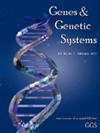BpEIL1负调控白桦对茄枯丝核菌和互花病菌的抗性。
IF 1.2
4区 生物学
Q4 BIOCHEMISTRY & MOLECULAR BIOLOGY
引用次数: 0
摘要
病原体攻击影响树木健康,造成相当大的经济损失,并对周围环境造成严重破坏。了解树木的抗病机制对树木育种很重要。在之前对桦树(Betula platyphylla×B.pendula)的研究中,我们鉴定了一种称为lmd的病变模拟突变体。我们发现BpEIL1的表达减少是lmd表型的原因。克隆后,我们在桦树中获得了几个BpEIL1过表达和抑制系。在这项研究中,我们克隆了BpEIL1启动子,发现BpEIL 1主要在叶片中表达,尤其是在叶脉中。利用BpEIL1过表达株系OE9、抑制株系SE13和非转基因株系NT,进一步研究了转基因株系的特性和BpEIL 1在桦树抗病性中的作用。在SE13中抗坏血酸过氧化物酶和过氧化氢酶活性显著增加。SE13对真菌病原Alternaria alternata和Rhizoctonia solani的抗性高于OE9和NT系。RNA-seq表明,SE13中富集了与信号转导、抗病性和植物免疫相关的途径。因此BpEIL1是桦树抗病性的负调控转录因子。本研究为桦树及其他树木的抗病性提供了参考。本文章由计算机程序翻译,如有差异,请以英文原文为准。
BpEIL1 negatively regulates resistance to Rhizoctonia solani and Alternaria alternata in birch.
Pathogen attacks affect tree health, causing considerable economic losses as well as serious damage to the surrounding environment. Understanding the disease resistance mechanisms of trees is important for tree breeding. In previous studies on birch (Betula platyphylla × B. pendula), we identified a lesion mimic mutant called lmd. We found that reduced expression of BpEIL1 was responsible for the phenotype in lmd. Following cloning, we acquired several BpEIL1 overexpression and suppression lines in birch. In this study, we cloned the BpEIL1 promoter and found that BpEIL1 was primarily expressed in leaves, particularly in veins. We further studied the traits of transgenic lines and the function of BpEIL1 in disease resistance in birch using the BpEIL1 overexpression line OE9, the suppression line SE13 and the non-transgenic line NT. We found that hydrogen peroxide accumulated in SE13 leaves. Ascorbate peroxidase and catalase activity significantly increased in SE13. SE13 was more resistant to the fungal pathogens Alternaria alternata and Rhizoctonia solani than were the OE9 and NT lines. RNA-seq indicated that pathways related to signal transduction, disease resistance and plant immunity were enriched in SE13. BpEIL1 is thus a negative regulatory transcription factor for disease resistance in birch. This study provides a reference for disease resistance of birch and other trees.
求助全文
通过发布文献求助,成功后即可免费获取论文全文。
去求助
来源期刊

Genes & genetic systems
生物-生化与分子生物学
CiteScore
1.50
自引率
0.00%
发文量
22
审稿时长
>12 weeks
期刊介绍:
Genes & Genetic Systems , formerly the Japanese Journal of Genetics ,
is published bimonthly by the Genetics Society of Japan.
 求助内容:
求助内容: 应助结果提醒方式:
应助结果提醒方式:


